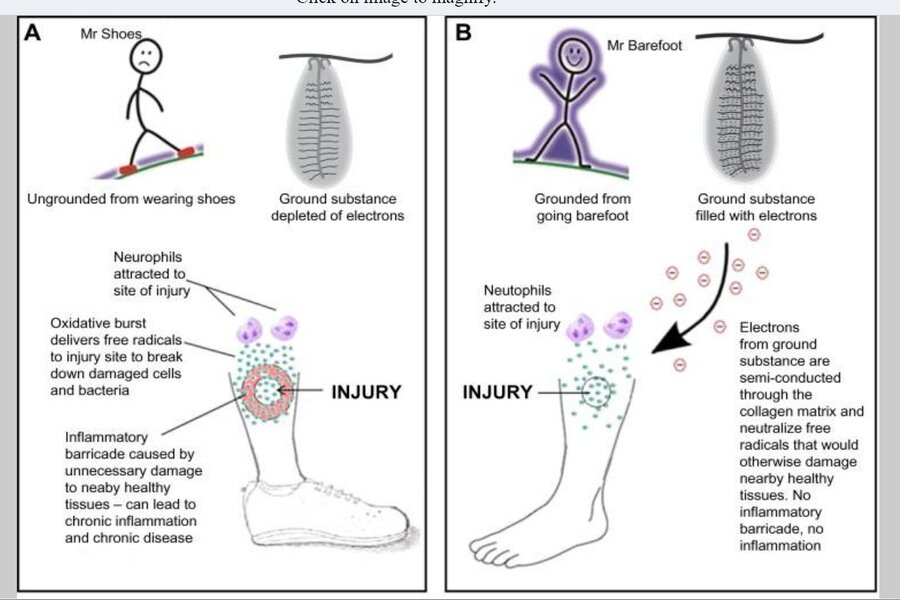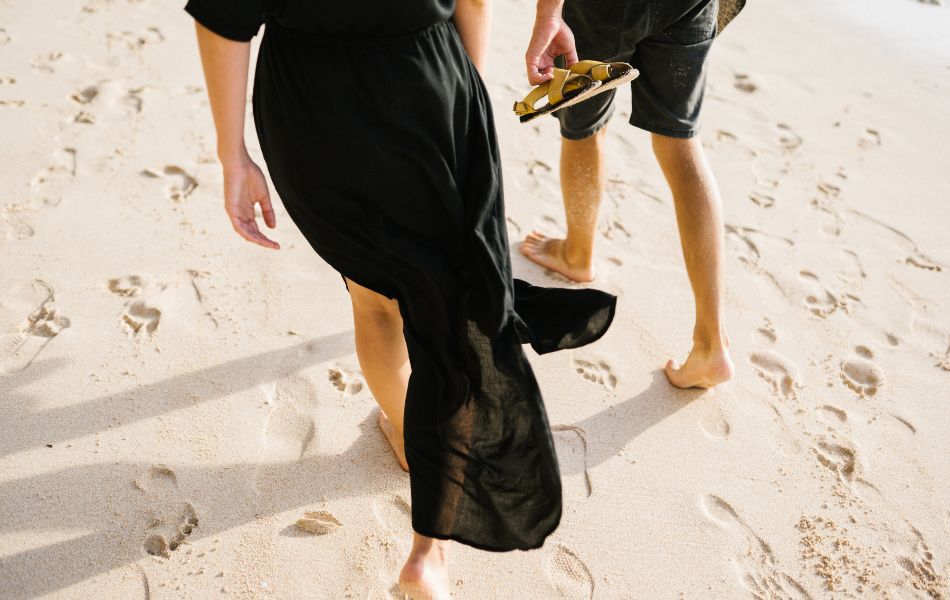Have you ever experienced the bliss of strolling through wet grass—how it massages your feet, soothing and stimulating them simultaneously? Humans have been walking barefoot for thousands of years as part of their daily routine. This simple act is not only an enjoyable experience, but it also has significant health benefits. Whether it’s improving circulation, strengthening muscles and bones, or aiding balance and stability, the physical and mental payoff of tiptoeing through the grass may be precisely what you need.
So, Let’s see what the benefits of walking are barefoot.
8 Physical and Mental Health Benefits of Walking Barefoot
Shoes limit the movement of toes and put pressure on specific areas of the feet. Walking barefoot allows all muscles and tendons in the feet to stretch and move naturally, distributing body weight evenly across the foot and reducing stress on specific joints.
When you walk barefoot, your feet, ankles, and legs work far more than when you wear shoes. This translates to better circulation and mobility in your lower body. And these help your body in such a way…
1. Reduces Chronic Pain and Improves Energy
According to research from The Ohio State University, the surface of our planet is rich in free electrons that can be transferred to humans through direct touch. When we walk barefoot, these electrons are absorbed into the body, which can neutralize the free radicals (positively charged particles) that cause inflammation and pain. This process can help alleviate various types of chronic pain, including arthritis, fibromyalgia, and other inflammatory conditions.

Based on the research from The Journal of Alternative and Complementary Medicine, Walking barefoot stimulates the nerve endings on the soles of your feet, which sends messages to the brain to release endorphins, the body’s natural painkillers. This can help reduce chronic pain in different body parts, including the back, neck, and joints.
Also, walking barefoot can give you more energy by making your blood flow faster and giving your body more oxygen. This can help you feel less tired and promote overall well-being.
2. Promotes Eyesight
Walking barefoot can even have a positive impact on your eyesight.
When you walk without shoes, the nerve endings on your feet send signals to your brain, promoting better sensory integration and overall neurological function. This effect extends beyond your feet and can positively influence other sensory organs, including your eyes.
Reflexology practitioners hold the belief that by applying pressure and massage to specific spots on the hands and feet, they can invigorate and revitalize various body parts. One way to activate these reflexology points is by walking barefoot, which stimulates the points on the soles of the feet that are linked to different areas of the body, such as the eyes.
Engaging in regular barefoot walking can help to promote healthy vision and enhance overall eye function by stimulating these reflexology points.
3. Reduces Stress (anxiety, depression, irritability)
Walking barefoot can help reduce stress as anxiety, depression, and irritability and promote a sense of calmness. A study found that walking barefoot on grass can lower stress hormones like cortisol, which can cause anxiety. Participants who spent time walking barefoot on grass had lower cortisol levels and reported feeling less anxious and more relaxed.
4. Boosts Immunity
A study found walking barefoot can boost your immunity by increasing the number of white blood cells in your body. White blood cells are responsible for fighting infections and diseases, and walking barefoot on natural surfaces can help stimulate their production.
Walking barefoot on soil can expose you to beneficial microorganisms that can help improve your gut health and boost your immune system.
According to the National Library of Medicine, free radicals are unstable molecules that can damage cells and impair immunity. Reducing free radicals through contact with the earth’s electrons promotes a more robust immune response. Some studies have also indicated that spending time barefoot outdoors may increase your body’s antiviral and antibacterial defenses.
5. Improves Mood
Walking barefoot can also help to improve mood and overall well-being. One reason for this is that direct contact with the Earth can release endorphins, our body’s natural “feel-good” hormones. Endorphins can help to lift our spirits, boost our mood, and create a sense of happiness and contentment.
Moreover, walking barefoot outdoors often means spending time in nature, another mood booster. Consistently, research has demonstrated that spending time in natural environments has favorable psychological effects, including improved mood, reduced stress, and increased feelings of happiness.
6. Improves Cardiovascular Health
Grounding from barefoot walking may support heart health in several ways. The influx of free electrons while walking barefoot reduces inflammation, oxidative stress, and plaque formation in the arteries. This helps prevent atherosclerosis, or clogging of the arteries, which improves circulation and blood flow.
NCBI has reported that when a person practices grounding, it can lead to an increase in the surface charge of red blood cells. This increase in surface charge can help to reduce the viscosity of blood and prevent clumping of the cells.
7. Improves Sleep Quality
Walking barefoot has been shown to have a positive impact on sleep quality. Grounding helps control our circadian rhythm, which is our body’s internal clock that controls when we sleep and wake up. A study found that individuals who practiced grounding had improved sleep quality and reduced nighttime awakenings compared to a control group.
Additionally, walking barefoot can help to reduce stress and anxiety levels, which are common contributors to sleep problems. By promoting relaxation and a sense of calm, walking barefoot can help pave the way for a better night’s sleep.
8. Improves Proprioception
Walking barefoot can significantly improve proprioception; proprioception is our sense of body awareness. Shoes can limit our foot’s ability to feel the ground, which can lead to compromised balance and coordination.
Conversely, walking barefoot makes our legs and feet’s tiny muscles work harder, gradually strengthening them. This lowers the possibility of accidents like sprains and falls and enhances our balance, agility, and coordination.
Some of the Potential Risks of Going Barefoot
Here are some potential risks associated with walking barefoot:
- According to certain studies, individuals who are susceptible to diabetic foot disease may be at risk of developing this condition as a result of walking barefoot.
- Cuts, scrapes, and puncture wounds. Without shoes to protect your feet, it’s easy to step on something sharp like glass, nails, thorns, etc. This can cause minor to serious injuries.
- Skin infections. Cuts or scrapes can become infected, especially if walking in areas with high bacteria levels like public showers or dirty urban streets. Risk increases if you have diabetes or poor circulation.
- Parasites. Hookworm and other parasites can enter through the soles of the feet when walking barefoot in tropical or developing countries.
- Frostbite. In very cold temperatures, bare feet can develop dangerous frostbite.
So, while walking barefoot can be enjoyable, it’s safest to do so at home or in sand/grass rather than on urban streets or rocky terrains. And watch out for hot, cold, or contaminated surfaces.
Tips for walking barefoot
Here are some key points to consider when walking and exercising barefoot:
- Start slow and gradually increase the distance and time of your barefoot walks.
- Pay attention to any new pain or soreness and slow down if you need to.
- Begin indoors on a safe and clean surface to allow your feet to adjust to the new environment.
- Move on to less dangerous areas outside, like grass, turf, rubber tracks, and sandy beaches.
- Use minimalist shoes to provide structure and padding as your feet adjust.
- Incorporate balance exercises, such as standing on one foot, pressing onto your toes, and lowering down slowly.
- Examine your feet daily for any injuries and seek medical attention if necessary.
- If you experience pain or discomfort, return to supportive shoes and start slowly once your feet have healed.
Conclusion
By walking barefoot, we benefit our health and well-being with each step. Nature is a vital resource for our overall well-being, inviting us to reconnect to ourselves and restore balance. Whether in the sand or on grass, the journey of a mindful walk yields its rewards– moments of mindfulness and a chance to unearth our inner strength. Take the first steps today and experience life anew.

